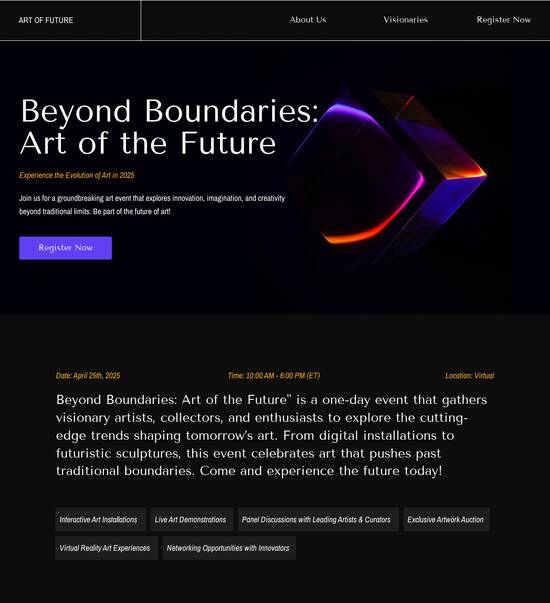
Website Template for Second Hand Stores
Explore Similar TemplatesAbout template
Create a customized landing page for your second hand store easily and efficiently. Choose from 500+ conversion-focused layouts and optimize for higher conversions with built-in experimentation features.
Recommended templates

Easy to build without coding
With the intuitive drag-and-drop builder, anyone on your team can create high-converting pages without any knowledge of code or design. Make enhancements to your landing page with custom widgets using Javascript, HTML/CSS, or third-party scripts.

Multiple layouts for any industry and goal
Select from 500+ landing page layouts built to boost conversions across industry-specific scenarios. Customize them by adjusting fonts, adding images, and generating on-brand content with the AI assistant. Quickly scale with Instablocks® and Global Blocks that you can save, reuse, and update globally.

Loads fast and looks polished on any device
Every template is responsive, which means they present professionally on any device and load blazingly fast with our Thor Render Engine. You can also power them up with Google AMP technology to deliver an unparalleled mobile experience and drive higher conversions.

Robust analytics & experimentation
Get real-time updates and reporting across all your devices, showing the number of visitors, conversions, cost-per-visitor, and cost-per-lead. Launch AI-powered experiments, run A/B tests, and use heatmaps to analyze user behavior, then optimize your landing page to maximize conversions.







Easy to build without coding
With the intuitive drag-and-drop builder, anyone on your team can create high-converting pages without any knowledge of code or design. Make enhancements to your landing page with custom widgets using Javascript, HTML/CSS, or third-party scripts.
Multiple layouts for any industry and goal
Select from 500+ landing page layouts built to boost conversions across industry-specific scenarios. Customize them by adjusting fonts, adding images, and generating on-brand content with the AI assistant. Quickly scale with Instablocks® and Global Blocks that you can save, reuse, and update globally.
Loads fast and looks polished on any device
Every template is responsive, which means they present professionally on any device and load blazingly fast with our Thor Render Engine.
Robust analytics & experimentation
Get real-time updates and reporting across all your devices, showing the number of visitors, conversions, cost-per-visitor, and cost-per-lead. Launch AI-powered experiments, run A/B tests, and use heatmaps to analyze user behavior, then optimize your landing page to maximize conversions.
All the features you need to build lead-generating landing pages
Explore more featuresLearn how to build top-performing landing pages for any goal
FAQs
Leading the way in building high-performing landing pages





Unleash the power of Instapage: Your guide to effective landing pages
Effective landing pages are vital for boosting conversion rates in your digital marketing campaigns. Instapage stands out as a powerful landing page and conversion rate optimization (CRO) platform, offering tools and features tailored for marketers across various industries, including business services, education, and technology. With over 100 customizable templates, Instapage simplifies the page creation process, enabling teams of any size to create high-performing landing pages that drive results without extensive technical knowledge.
Choosing the Right Template for Your Campaign
Selecting the perfect landing page template is the first step towards successful lead generation. Instapage offers a library of over 100 high-converting templates, which cater specifically to diverse business needs. These templates are designed to be both user-friendly and visually appealing, ensuring that they resonate with your target audience in the USA. Factors to consider while choosing a template include overall design, industry relevance, and lead generation features.
- Design Relevance: The template should visually connect to your branding, enhancing recognition.
- Mobile Optimization: Ensure that the template is responsive and provides a seamless experience across devices.
- Lead Capture Features: Opt for templates that include forms, buttons, and call-to-action elements facilitating quick lead capture.
Utilizing Instablocks for Efficient Page Building
Instablocks enable marketers to create landing pages more efficiently by allowing the reuse of custom-built sections. This feature streamlines the design process, ensuring consistency across your campaigns. With just a few clicks, you can add a pre-designed block that matches your brand aesthetic, enhancing workflow productivity.
Optimizing Your Landing Pages for Better Conversion Rates
Optimization is key to maximizing ROI. Instapage provides built-in experimentation tools, including A/B testing and heatmaps, that allow you to observe user behavior on your landing pages. By testing different layouts, calls to action, and content strategies, you can pinpoint what resonates most with your audience, leading to higher conversion rates.
- A/B Testing: Experiment with variations of your landing page to determine which elements drive the best results.
- Heatmaps: Analyze user interaction to see where visitors click most, allowing for informed adjustments.
- Performance Analytics: Review comprehensive analytics to assess your page's efficacy based on real data.
Personalizing User Experience for Targeted Audiences
Creating tailored experiences for your visitors can significantly impact engagement levels. Instapage employs dynamic text replacement and audience-level tracking, allowing you to deliver personalized content. This flexibility not only increases relevance but also enhances user engagement, leading to improved conversion rates.
- Dynamic Text Replacement: Automatically swap out text on your landing pages based on user data to create a personalized feel.
- AdMaps: Align your advertising campaigns with specific landing pages to ensure continuity and relevance during the user's journey.
- Audience Metrics: Utilize data-driven insights to refine your content strategy, ensuring it resonates with your diverse audience segments.
By leveraging the capabilities of Instapage, marketers can enhance their campaign effectiveness, ensuring higher lead conversion through targeted and optimized landing pages.
Ready to transform your landing pages? Sign up for Instapage today and unleash the potential of your digital marketing campaigns.
Website template for second-hand stores: Creating a unique online presence
Understanding the unique needs of second-hand stores
Second-hand stores have witnessed a remarkable transformation in recent years, becoming favorite shopping destinations for many. This shift stems from a growing consumer awareness regarding sustainability and a desire to find unique, budget-friendly items. More individuals are now prioritizing thrift culture, seeing it not only as a financial choice but also as a conscious avenue that supports environmental preservation. As a result, second-hand shopping has cultivated a community that celebrates the value of reused goods, making it essential for these stores to effectively represent themselves online.
With the increasing demand for second-hand products, having a specialized website template becomes crucial. These templates need to cater specifically to the target demographic, showcasing not only the products but also the values and stories behind them. A well-designed template helps establish brand visibility, fosters customer trust, and enhances the overall online experience, connecting deeply with an audience that values community and environmental impact.
Key features of an ideal second-hand store template
An engaging layout design is paramount for drawing customers into the world of second-hand retail. The visual appeal of a website can drastically influence shopping experiences, prompting customers to spend more time browsing through collections. Best practices dictate that second-hand stores should prioritize high-quality images of items, providing clear visibility of clothing finds. User-friendly navigation plays a key role, ensuring that customers can smoothly browse categories, product ranges, and filter options without frustration.
Utilize vibrant and high-resolution images to showcase products effectively.
Segment product listings into categories for easier navigation.
Incorporate call-to-action buttons that lead directly to purchasing options.
Advanced filtering tools also play a critical role in enhancing user experience. Customers should be empowered to find exactly what they seek by searching for products based on various parameters such as brand, size, color, and the item's condition. This helps streamline their shopping experience, reassuring them that their values align with eco-conscious choices. Not only do these features improve user satisfaction, but they also help tailor marketing strategies to match customer preferences.
Building a strong community connection
Building connections with the community is essential for second-hand stores. Integrating social media feeds directly onto the website creates an engaging environment where customers can interactively participate in the brand's story. Social platforms encourage user-generated content through hashtags and posts, reinforcing community loyalty and inviting customers to share their unique finds and experiences with others.
Creating a dedicated forum for fashion enthusiasts can also enhance community interaction. This space can be dedicated to sharing tips on sustainable fashion, second-hand treasures, and style transformations. A forum encourages discussions that foster a sense of belonging among users, enabling them to exchange insights, seek advice, and develop relationships around shared interests in sustainable practices.
Optimizing the shopping experience for customers
In a world that heavily favors the use of mobile devices, ensuring the website is mobile-optimized is a vital element of a successful online store. A mobile-friendly design significantly increases customer satisfaction, making their shopping experience seamless. Key elements include responsive layouts that adapt to various screen sizes, ensuring that customers enjoy a consistent experience whether they're on a smartphone or desktop. By understanding how users navigate on mobile, second-hand stores can streamline the purchase process and remove obstacles that lead to cart abandonment.
Ensure that the checkout process is simplified to minimize abandonments.
Provide multiple payment options to cater to diverse customer preferences.
Integrate trust signals such as security badges to enhance purchase confidence.
Post-purchase engagement is equally important in building long-term customer loyalty. Using automated emails for confirmations and updates keeps customers informed and valued. Asking for feedback post-purchase can enrich the shopping experience by capturing customer satisfaction levels, while personalized suggestions can excite them for future shopping endeavors.
Measuring success and impact in the second-hand market
Utilizing analytics can provide valuable insights into customer behavior, allowing second-hand stores to tailor their offerings effectively. Understanding customer interactions, tracking popular items, and shifting shopping trends can inform inventory decisions, ensuring that shops maintain an up-to-date selection that meets their clientele's tastes. Insights gained from data help in adjusting marketing strategies to better engage with customers, enhancing the overall efficiency of promotional efforts.
Implement analytics tools to track customer journeys and popular items.
Evaluate customer data regularly to inform size, color, and brand offerings.
Adapt marketing strategies based on shopping patterns.
Establishing a loyalty program can be particularly effective in fostering brand loyalty. By offering exclusive deals or first-look access to new items for repeat customers, second-hand stores can reward loyal shopping behaviors. Additionally, showcasing customer testimonials boosts credibility, helping to build trust among potential customers who may be hesitant to make purchases.
Available support tools for owners and customers
A dedicated support team is crucial for addressing issues that arise for both owners and customers. Having accessible resources, such as FAQs and DIY fixes, can greatly enhance user experiences, ensuring that inquiries and concerns are promptly resolved. Quick response times from support staff contribute to customer satisfaction, building relationships based on reliability and trust.
Shop owners also benefit from educational resources that enhance their effective use of the website template features. Training sessions on marketing strategies, community engagement methods, and template functionalities facilitate ongoing learning and adaptation. These resources enable them to optimize their stores continuously, ensuring they keep pace with evolving market demands and customer preferences.
The path forward: Innovating second-hand store operations
In order for second-hand stores to thrive, they must anticipate future trends in fashion. Staying ahead of shifting consumer behaviors necessitates innovative website templates that easily adapt to market needs. Collaborations with popular brands or local designers can elevate the store's image, aligning with trends while fostering community ties.
Simultaneously, aligning the brand with sustainability values inherently attracts eco-conscious consumers. Integrating eco-friendly processes into operations strengthens commitment to responsible shopping. By sharing the environmental benefits associated with second-hand buying, stores can educate customers, further embedding sustainability in their brand ethos.
Research emerging consumer trends to align offerings accordingly.
Develop partnerships that enhance brand recognition and introduce fresh inventory.
Launch campaigns that educate consumers about sustainability efforts and impacts.
Moreover, envisioning an inclusive shopping environment encourages participation from diverse customer bases. By focusing on representation within clothing offerings and actively seeking feedback from community members, second-hand stores can win the trust of both new and returning customers. Building an inclusive identity strengthens the overall community connection, ensuring that every voice is heard and valued.
Ready to skyrocket conversions?
Supercharge your ad campaigns with high-performing landing pages
Get started














